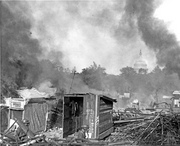Wall Street isn’t DC’s first “occupation”
Public discourse has varied over the power, impact, and ultimately resolution of the encamped protests in McPherson Square and Freedom Plaza as they have grabbed headlines over the past two months. “Occupy” is merely the latest in a long string of DC protests.
In their scope and length, McPherson’s Occupy DC and Freedom Plaza’s Stop The Machine groups share characteristics with protests of the past: links to related protests across the country, ties to liberal political groups, and relatively well-developed internal structures and governance.
Coxey’s Army
In response to the Panic of 1893, several “armies” marched on Washington, DC demanding unemployment aid and relief. The best known, Coxey’s Army, was led by wealthy populist and political figure Jacob Coxey.
Launched in Ohio with 100 unemployed men, the protest moved through Pennsylvania, gathering strength. In the spring of 1894, Coxey’s Army arrived 500 strong in Washington. Public interest and attention quickly fizzled, however, after Coxey and his followers were arrested for trespassing on the Capitol grass while trying to storm Congress.
Two decades later, in 1914, Coxey regenerated his army of “tramps” and marched on DC again. This time, Coxey was able to address a crowd from the steps of the US Capitol without being arrested; but his march made little lasting impact on the city or on national policy.
Resurrection City
After the assassination of Dr. Martin Luther King, Jr. in April 1968, leaders of the Southern Christian Leadership Conference continued plans already in motion to descend upon Washington. Members of the Poor People’s Campaign, focusing on inequity in employment and housing, arrived in DC in mid-May. In the shadows of the Lincoln Memorial, the epicenter of 1963’s March on Washington, “Resurrection City” quickly but haphazardly formed with a collection of self-constructed shacks. Deluged by rain and poor planning, the group quickly became a burden to the Johnson administration. By that summer, the protest had disintegrated.
According to the July 5th edition of Time Magazine,
Churning through the trash-strewn gumbo that had once been a manicured meadow, a federal bulldozer last week interred the last traces of Resurrection City. Its few remaining inhabitants scattered or imprisoned, the shantytown capital and symbol of the Poor People’s Campaign had long since become an ugly, anarchic embarrassment to their cause.
Bonus Army
The Great Depression’s Bonus Army is arguably the most well-known occupation-style protest that Washington has seen. According to
The Bonus Army: An American Epic
In the summer of 1932, at the height of the Depression, some 45,000 World War 1 veterans - whites and blacks together - descended on Washington, DC from all over the country to demand the bonus promised them eight years earlier for their wartime service. earing violence after the Senate defeated the “bonus bill” Herbert Hoover’s Army Chief of Staff, Douglass MacArthur led tanks through the streets on July 28 to evict the bonus marchers.
Set up on on the site of the old Anacostia flats, men, women, and children alike camped in structures built from materials scavenged from a nearby dump, but in a tightly-controlled environment in which veterans laid out streets, built sanitation facilities, and created an internal civil structure.
With martial law invoked, the Army set the shacks ablaze, and the veterans and their families left the city. Whether a result of the Bonus Army or not, that fall, President Hoover lost in a landslide to Franklin Roosevelt. Eventually, in 1936, Congress passed the “Bonus Act” that would pay out nearly $2 billion to WWI veterans.
If past is prologue and we can glean lessons from these past protests, Occupy DC and Stop the Machine might have ignominious conclusions. Time — and perhaps the onset of winter — will be the judge.

